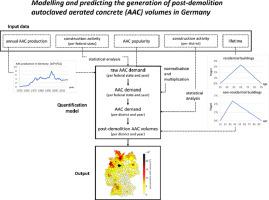Resources, Conservation and Recycling ( IF 11.2 ) Pub Date : 2021-05-19 , DOI: 10.1016/j.resconrec.2021.105504 Justus J. Steins , Rebekka Volk , Frank Schultmann

|
Autoclaved aerated concrete (AAC) has a porous structure and excellent thermal properties. Therefore, it is a frequently used building material for masonry units, prefabricated reinforced components and lightweight mineral insulation boards with increasing popularity. Post-demolition AAC is currently mainly disposed of in landfills. Decreasing landfill capacities, the legal framework, and protection of primary resources require developing recycling options for AAC. However, so far, no overall recycling of post-demolition AAC has been established yet. Only AAC primary process waste is recirculated or discharged, for example as an absorbent for chemicals or animal bedding. For high-quality post-demolition AAC recycling, only minimal information about recyclable volumes and their regional distribution is available. Therefore, a new dynamic retrospective and prospective AAC quantification model on a national level using AAC production, construction activity, AAC popularity, and buildings’ lifetimes is developed to assess geographically distributed current and future post-demolition AAC volumes. This new model is applied to quantify post-demolition AAC volumes in a case study for Germany in the period between 1950 and 2050. For validation, the results are compared with two different approaches and with data from the literature. The AAC quantification allows decision support for the circular management of AAC during its life cycle and along its value/supply chain regarding design, location planning, logistics, production, and recycling.
中文翻译:

建模和预测直到2050年德国拆除后的高压加气混凝土(AAC)的体积
高压灭菌加气混凝土(AAC)具有多孔结构和出色的热性能。因此,它是砖石单元,预制增强组件和轻质矿物绝缘板的常用建筑材料,并且越来越受欢迎。拆除后的AAC目前主要在垃圾填埋场处置。垃圾掩埋能力,法律框架和主要资源的减少要求开发AAC的回收方案。但是,到目前为止,尚未建立拆卸后AAC的整体回收利用。仅将AAC主过程废料再循环或排出,例如用作化学药品或动物垫料的吸收剂。对于高质量的拆除后AAC回收,仅提供有关可回收量及其区域分布的最少信息。所以,建立了一个新的动态回顾性和前瞻性AAC量化模型,该模型使用AAC的生产,建筑活动,AAC受欢迎程度和建筑物的使用寿命,在全国范围内评估了当前和未来拆除后AAC的地理分布。在1950年至2050年的德国案例研究中,此新模型用于量化拆除后的AAC体积。为了进行验证,将结果与两种不同的方法进行比较,并与文献数据进行比较。AAC量化可以为AAC在其生命周期内以及沿其价值/供应链的设计,位置规划,物流,生产和回收利用的循环管理提供决策支持。开发建筑物的寿命来评估地理分布的当前和将来的拆除后AAC量。在1950年至2050年的德国案例研究中,此新模型用于量化拆除后的AAC体积。为了进行验证,将结果与两种不同的方法进行比较,并与文献数据进行比较。AAC量化可以为AAC在其生命周期内以及沿其价值/供应链的设计,位置规划,物流,生产和回收利用的循环管理提供决策支持。开发建筑物的寿命来评估地理分布的当前和将来的拆除后AAC量。在1950年至2050年的德国案例研究中,此新模型用于量化拆除后的AAC体积。为了进行验证,将结果与两种不同的方法进行比较,并与文献数据进行比较。AAC量化可以为AAC在其生命周期内以及沿其价值/供应链的设计,位置规划,物流,生产和回收利用的循环管理提供决策支持。将结果与两种不同的方法以及来自文献的数据进行比较。AAC量化可为AAC在其生命周期内以及沿其价值/供应链的设计,位置规划,物流,生产和回收利用的循环管理提供决策支持。将结果与两种不同的方法以及来自文献的数据进行比较。AAC量化可以为AAC在其生命周期内以及沿其价值/供应链的设计,位置规划,物流,生产和回收利用的循环管理提供决策支持。











































 京公网安备 11010802027423号
京公网安备 11010802027423号